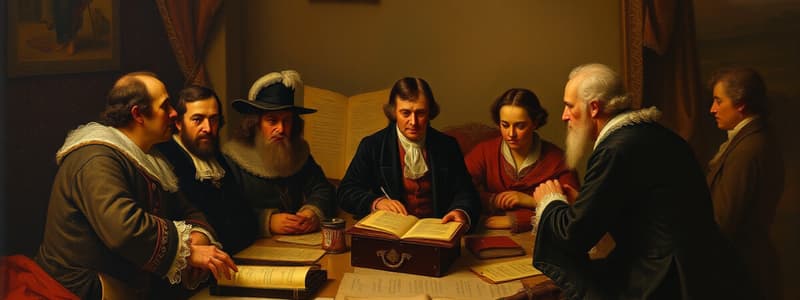Podcast
Questions and Answers
What was the primary function of the Articles of Confederation?
What was the primary function of the Articles of Confederation?
- To create a judicial system
- To provide a strong centralized government
- To organize and mobilize the thirteen colonies (correct)
- To establish an executive branch
Which issue was NOT addressed by the Articles of Confederation?
Which issue was NOT addressed by the Articles of Confederation?
- Establishment of a bicameral legislature (correct)
- No authority to levy taxes
- No judicial branch
- Lack of an executive power
What significant weakness did the Articles of Confederation present diplomatically?
What significant weakness did the Articles of Confederation present diplomatically?
- Lack of a common currency
- Establishment of trade tariffs
- States could violate international treaties (correct)
- Ability to print money
What year was the Articles of Confederation finalized?
What year was the Articles of Confederation finalized?
What term became widespread to describe the worthless money printed under the Articles of Confederation?
What term became widespread to describe the worthless money printed under the Articles of Confederation?
Which of the following was a major claim made by American nationalists regarding the Articles of Confederation?
Which of the following was a major claim made by American nationalists regarding the Articles of Confederation?
How did the Articles of Confederation structure the legislative body?
How did the Articles of Confederation structure the legislative body?
What was a consequence of the Articles of Confederation's lack of taxing authority?
What was a consequence of the Articles of Confederation's lack of taxing authority?
What system of voting power was established in the Articles of Confederation?
What system of voting power was established in the Articles of Confederation?
What major change did the Constitution introduce compared to the Articles of Confederation?
What major change did the Constitution introduce compared to the Articles of Confederation?
In which year was the American Constitution adopted?
In which year was the American Constitution adopted?
What is one of the key components established by the Constitution that outlines the relationship between the Federal Government and the states?
What is one of the key components established by the Constitution that outlines the relationship between the Federal Government and the states?
How many amendments does the U.S. Constitution currently have?
How many amendments does the U.S. Constitution currently have?
What significant issue was not addressed by the original Constitution?
What significant issue was not addressed by the original Constitution?
What does the Constitution provide among the three branches of government?
What does the Constitution provide among the three branches of government?
What historical legislation was enacted as the 18th Amendment to the Constitution?
What historical legislation was enacted as the 18th Amendment to the Constitution?
Flashcards are hidden until you start studying
Study Notes
Articles of Confederation
- First successful organizational effort for the thirteen original colonies of the United States.
- Inception aimed at establishing unity among colonies and facilitating foreign assistance during the Revolutionary War.
- Ratified in 1781, functioning alongside the Declaration of Independence and the Model Treaty.
- Provided the colonial powers with some leverage for diplomatic negotiations, including land deals with foreign governments.
- Lacked a strong central authority, leading to issues in governance and international relations post-Revolution.
Weaknesses of the Articles of Confederation
- Absence of an executive branch to enforce laws or lead governance.
- No judicial branch to resolve disputes between states or enforce treaties.
- Individual states could violate international treaties, harming U.S. diplomatic relations.
- No taxing authority to collect funds for war expenses or national debt, leading to possible financial instability and depreciation of printed currency.
Transition to the Constitution
- The Constitution was adopted in 1789 to provide a more centralized and authoritative governance structure.
- Established a bicameral legislature, unlike the unicameral system of the Articles of Confederation.
- Introduced a single vote for each legislative representative from each state, based on population census, enhancing democratic representation.
- Created an Executive Branch accountable to the public and established a system of checks and balances among the three branches of government.
Key Features of the Constitution
- Enumerates the relationship between the Federal Government and the states, clarifying jurisdiction and authority.
- Introduced the Bill of Rights, which consists of the first ten amendments protecting individual civil liberties.
- Unique for its time, it influenced the democratic reforms of several other countries.
Amendments and Legacy
- The Constitution is intentionally vague on several major issues, including slavery, leading to ongoing debates and amendments.
- Has been amended 27 times since its inception, adapting to changing societal needs (e.g., the 18th Amendment introduced Prohibition).
- Despite its length, the U.S. Constitution is one of the shortest written constitutions in contemporary existence, showcasing its foundational nature and adaptability.
Studying That Suits You
Use AI to generate personalized quizzes and flashcards to suit your learning preferences.




